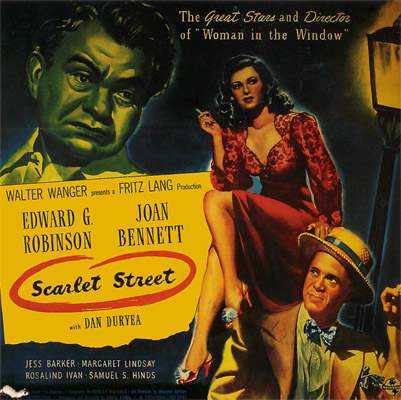
Watch On Bruised Onion Studio YouTube Channel
Scarlet Street (1945)
American film noir.
When a man in mid-life crisis befriends a young woman, her fiancé persuades her to con him out of the fortune they mistakenly assume he possesses.
Less of a film noir than it is a drama centered on morals, “Scarlet Street” is unexpectedly mature and surprisingly bleak for its time period.
Scarlet Street reunited director Fritz Lang with actors Edward G. Robinson, Joan Bennett and Dan Duryea, who had worked with him in The Woman in the Window (1944).
Interesting Trivia:
Local authorities in three cities (New York, Milwaukee, and Atlanta) banned Scarlet Street early in 1946 because of its dark plot and themes.
In 1995, Matthew Bernstein wrote in Cinema Journal: “The film is a dense, well-structured film noir and has been analyzed and interpreted numerous times. Some of the earliest interpretations came from censors in three different cities,” adding:
On January 4, 1946, the New York State Censor Board banned Scarlet Street entirely, relying on the statute that gave it power to censor films that were “obscene, indecent, immoral, inhuman, sacrilegious” or whose exhibition “would tend to corrupt morals or incite to crime.” As if in a chain reaction, one week later the Motion Picture Commission for the city of Milwaukee also banned the film as part of a new policy encouraged by police for “stricter regulation of undesirable films.”
On February 3 Christina Smith, the city censor of Atlanta, argued that because of “the sordid life it portrayed, the treatment of illicit love, the failure of the characters to receive orthodox punishment from the police, and because the picture would tend to weaken a respect for the law,” Scarlet Street was “licentious, profane, obscure and contrary to the good order of the community.”… Universal was discouraged from challenging the constitutionality of the censors by the protests of the national religious groups that arose as the Atlanta case went to court.
Universal Pictures and Diana Productions sued the city of Atlanta, claiming that the state censor did not have the authority to ban the film, and that only the entire state Board of Censors, who tied on their vote, could make such a decision. Georgia’s lower court demurred judgment in Apr 1946, while the film was still in its first run. The city of Atlanta appealed to the state Supreme Court, who reversed the demurrer on a legal technicality in Sep 1946.
The twelve paintings done for the film by John Decker were sent to the Museum of Modern Art in New York City for exhibition in March 1946.
| Directed by | Fritz Lang |
|---|---|
| Produced by | Walter Wanger Fritz Lang |
| Screenplay by | Dudley Nichols |
| Based on | La Chienne 1931 novel and play by Georges de La Fouchardière (novel) André Mouézy-Éon (play) |
| Starring | Edward G. Robinson Joan Bennett Dan Duryea |
| Music by | Hans J. Salter |
| Cinematography | Milton R. Krasner |
| Edited by | Arthur Hilton |
|
Production
company |
Walter Wanger Productions
Fritz Lang Productions Diana Production Company |
| Distributed by | Universal Pictures |
|
Release date
|
|
|
Running time
|
102 minutes |
| Country | United States |
| Language | English |
| Budget | $1,202,007 |
| Box office | $2,948,386 |
